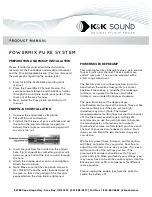
794380D / 0914
1. INTRODUCTION
13
the extra time. Consequently, the average activity of the short-lived isotope will be under-
estimated.
If you anticipate significantly varying counting rates during the time taken to acquire the spec-
trum, the CORR_ERR ZDT mode should be used. The CORR_ERR mode corrects for dead-
time losses over minuscule time intervals by adding counts to the ZDT spectrum in proportion to
the instantaneous ratio of real time to live time. Thus, the dead-time correction can correctly
track rapidly changing counting rates. The CORR_ERR mode should be used whenever the
counting rate might change significantly during the measurement time. In addition to the
rapidly-decaying isotope example above, the CORR_ERR mode should be used when monitor-
ing cooling water flow from a nuclear reactor. The CORR_ERR mode accommodates brief
bursts of high-activity in the water flowing past the gamma-ray detector. Both the corrected and
error spectra are stored in the resulting spectrum file.
Note that the counts in the ZDT spectrum must be divided by the elapsed REAL time to compute
the dead-time corrected counting rate. It is important to note that the standard deviation in the
N
ZDT
counts in a gamma-ray peak in the ZDT spectrum is not
. Instead the standard devia-
tion is obtained from the N
ERR
counts in the same peak ROI in the accompanying error spectrum.
The standard deviation in this case is
. And the standard deviation in the computed count-
ing rate,
, is
.
1.6.4.1. The NORM_CORR Diagnostic Mode
Why is there a NORM_CORR mode, and why should you avoid using it? This mode simul-
taneously collects the ZDT spectrum and the conventional uncorrected spectrum. It is useful for
demonstrating that the counts in the uncorrected spectrum divided by the live time is the same
counting rate as the counts in the ZDT spectrum divided by the real time, in the special case of
constant counting rate. Because the error spectrum is not collected in NORM_CORR mode, the
standard deviation in the ZDT counts cannot be calculated if the counting rate is varying. The
spectroscopy software provides some protection for users if the ZDT-LTC mode is inadver-
tently selected. In this case, the software ignores the ZDT spectrum and presumes you intended
to use the uncorrected spectrum in a constant-counting-rate application.
1.6.4.2. To Summarize
Use the ZDT Off mode when the counting rate is expected to be constant during the time
taken to acquire the spectrum.
Use the ZDT CORR_ERR mode when the counting rate is expected to change or might
change significantly during the time required to acquire the spectrum.
Содержание DSPEC Pro
Страница 4: ...iv Intentionally blank...
Страница 9: ...ix Intentionally blank...
Страница 10: ...x...
Страница 106: ...DSPEC Pro Digital Gamma Ray Spectrometer User s Manual 794380D 0914 96 Intentionally blank...
Страница 108: ...DSPEC Pro Digital Gamma Ray Spectrometer User s Manual 794380D 0914 98 Intentionally blank...
















































